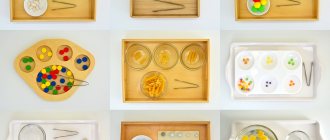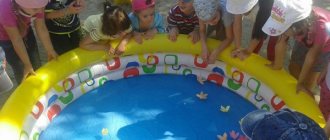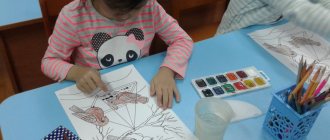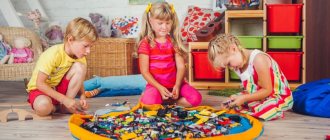8.Who does what? (use of photographs)
Goal: clarification and expansion of the passive verbal dictionary of children. Materials: To play this game, you need to ask parents to take photographs in which the child performs various actions (see dictionary). How to play: Children love to look at photographs of themselves. It is useful to use this in speech therapy classes. This game is initially played individually, using photographs of the child. At first, you can use only part of the photos. Gradually, as you master the material, add the rest. Place the photos in front of your child. Look, these are your photos. Here is Vanechka. And here is Vanechka. In every photo you do something interesting. Show me where you are sitting. Where do you eat? Where do you swim? Etc. In the future, you can play this game in a group. To do this, you should use photographs of different children selectively so that one action is not repeated twice in the photographs. Look, these are your photos. What are you doing? Find and show who is sleeping. That's right, Tanya. Who combs his hair? Sasha. Who's running? Olya is running. Etc. In the same way, you can conduct classes using photographs of the child’s loved ones performing various actions (see dictionary). This work is carried out individually. Show me where mom washes the dishes. Show me a photo of dad hammering a nail. Show me where my brother draws. Etc.
10.Where is there a lot and where is there little?
Goal: to teach children to distinguish between the grammatical forms of singular and plural nouns. Materials: subject pictures that depict various objects in quantities of one or many (can be selected from visual material on the development of mathematical concepts). How to play: Place pictures in front of the children. Then give the task. Show me where the butterfly is. Where are the butterflies? Where's the ball? Where are the balls? Where is the flower? Where are the flowers? Etc.
6. Follow commands!
Goal: clarification and expansion of the passive verbal dictionary of children. How to play: The game is played on the carpet. Place children at a sufficient distance so that they do not interfere with each other's movements. Stand in front of the children. Let's play this game: I will give commands, and you carry them out. Listen carefully and make no mistakes! Let's start! Go. Stop. Raise your hands up. Put your hands down. Sit down. Stand up. Jump. Run. Clap. Stomp. Place your hands on your belt. Etc. In this game, you can use simple movements familiar to children, which were practiced in an imitative game, when the teacher named and performed the movement, and the children repeated after him. The teacher monitors the children’s movements and corrects mistakes.
7.What is the little man doing?
Goal: clarification and expansion of the passive verbal dictionary of children. Materials: a set of pictures depicting various actions according to the number of children. How to play: Before starting the game, give the children one picture each. Look, in your pictures there are boys and girls doing something. Let's play an interesting game. I will make plans for actions, and you listen carefully. Let the one who has a suitable picture raise his hand. Who's sitting? Who's standing? Who's lying? Who's riding? Who's eating? Who drinks? Who is jumping? Etc. If kids find it difficult to answer, you can give a hint by expanding the instructions. To do this, add a description of the items that are in the picture. Who eats the apple? Who swings on the swing? Who is sitting on the chair? And so on.
Groups of words suggested for memorization.
1. Subject dictionary.
Toys: ball, cube, car, doll, bear, bunny, ball, spinning top, bucket, shovel, pencils, book, etc. Parts of the body, face: legs, arms, belly, back, finger, head, neck, hair, eyes , ears, mouth, lips, teeth, nose, cheeks, eyebrows, forehead. Clothing and footwear: hat, scarf, mittens, jacket, coat, dress, skirt, blouse, shirt, trousers, tights, briefs, T-shirt, socks, slippers, boots, shoes, sandals, etc. Toilet items: soap, toothbrush, toothpaste, sponge, towel, comb, handkerchief, etc. House, apartment: house, door, lock, key, stairs, elevator, window, kitchen, room, bathroom, lamp, floor, ceiling, wall, etc. Furniture: table, chair, sofa, bed, wardrobe, shelf, hanger, etc. Household items: TV, telephone, clock, stove, refrigerator, fork, spoon, plate, cup, blanket, pillow, mirror, etc. Food and dishes : bread, bun, cheese, sausage, sausages, milk, butter, sour cream, cottage cheese, yogurt, cookies, juice, egg; porridge, soup, salad, sandwich, tea, compote, etc. Vegetables and fruits: cabbage, potatoes, carrots, onions, cucumbers, tomatoes; orange, banana, apple, pear, plum, etc. Plants: tree, bush, grass, flowers, berries, etc. Names of animals and birds that the child often sees: dog, cat, bird, dove, sparrow, crow, horse, etc. etc. Individual names of objects in the surrounding life: street, road, traffic light, cars, plane, swing, slide, park, etc. Individual names of phenomena in the surrounding life: water, earth, sun, sky, rain, snow, night, day, etc.
2. Verb dictionary.
The child’s own actions: walks, sits, stands, runs, jumps, sleeps, eats, plays, draws, builds, walks, rolls, washes, bathes, dresses, undresses, combs his hair, carries, falls, screams, speaks, sweeps, wipes and etc. Names of actions that people close to the child perform: reads, writes, draws, cleans, washes, irons, cooks, fries, sweeps, etc. Other actions: the phone rings; the car drives and hums; The plane is flying; leaves are falling, etc.
3. Adjectives, adverbs.
Names of some sensations and states: sweet, salty, sour, wet; cold, warm, hot, painful, tasty.
The name of some concepts: big, small; a lot, a little.
Work to expand the passive vocabulary of non-speaking children 2-3 years old is carried out both by a speech therapist and by the child’s relatives. Therefore, a speech therapist not only works with the child, but also works with parents.





